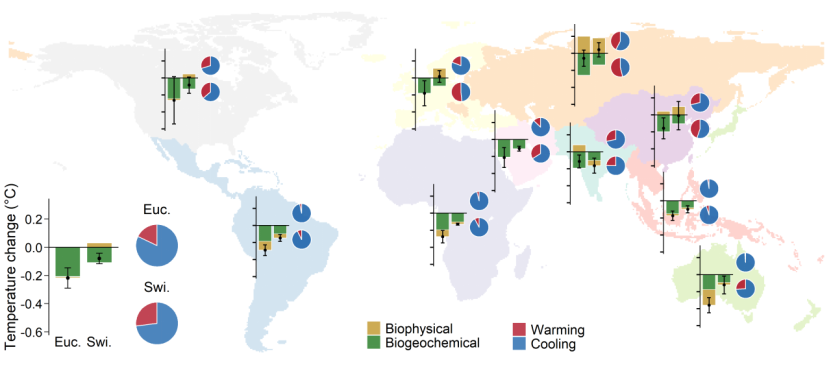The production of bioenergy with carbon capture and storage (BECCS) is a pivotal negative emission technology for realizing the carbon neutrality goal and mitigating climate change. Its basic principle is to fix CO2 through plant growth by cultivating bioenergy crops. After the use of bioenergy, CO2 emitted can be captured and stored, thus reducing CO2 concentration in the atmosphere. The reduction of atmospheric CO2 concentration can reduce the global radiative forcing of this greenhouse gas (GHG), and thus control the rise of temperature, which is the biogeochemical cooling effect. At the same time, bioenergy crop cultivation modifies land surface properties (such as albedo, evapotranspiration and surface roughness), and then affects the local energy budget, leading to temperature changes, that is, biophysical effects. Because of the absence of large-scale field planting of energy crops at present, the global land temperature effect of bioenergy crop cultivation mainly depends on model simulation, and the impact of biogeochemical and biophysical effects on global land temperature changes is yet to be clarified.
Li Wei’s Research Group of the Department of Earth System Science (DESS), Tsinghua University has conducted research on the above problem to disclose the impact of global large-scale bioenergy crop cultivation on global land temperature, and explore the contribution of biogeochemical and biophysical effects of different cultivation strategies (i.e., different types of bioenergy crops, spatial distribution of cultivation area, and cultivation areas) to temperature change.
The research group, in conjunction with many research institutions at home and abroad, applies the bioenergy crop module independently developed in the dynamic global vegetation model to simulate, and obtains the response curves of vegetation and soil carbon pools after different types of land use are converted into the cultivation of bioenergy crops. The research group further develops a bookkeeping model for calculating the carbon emissions of bioenergy crops, estimates the net CO2 removal (CDR) through biomass harvesting, carbon capture and storage, land use change and other processes in combination with different bioenergy crop cultivation scenarios, and simulates the biogeochemical temperature effects from each scenario by using a simplified earth system model. At the same time, the research group quantifies the terrestrial biophysical effects from the future bioenergy crop planting scenarios by coupling the bioenergy crop version of the dynamic global vegetation model with the atmospheric model. It is found in the study that by the end of this century, the cumulative CDR from the cultivation of eucalypt (72−112 Pg C) is larger than that of switchgrass (34−83 Pg C). The combined biogeochemical and biophysical effects are cooling (−0.26 to −0.04 °C) at the global scale, but 13−28% of land areas still have net warming signals, mainly due to the spatial heterogeneity of the biophysical effects. Our study shows that the deployment of bioenergy crop cultivation should not only be guided by the principles of maximizing yield and CDR but should also take an integrated perspective that includes all relevant Earth system feedbacks.
The above related results have been published in Environmental Science & Technology as an article titled “Temperature changes induced by biogeochemical and biophysical effects of bioenergy crop cultivation” . Dr. Wang Jingmeng of the DESS, Tsinghua University is the first author of the article, and Associate Professor Li Wei is the corresponding author. Co-authors include Professor Philippe Ciais of Laboratoire des Sciences du Climat et de l’Environnement (LSCE) and Researcher Thomas Gasser of International Institute for Applied Systems Analysis (IIASA), Researcher Chang Jinfeng of the College of Environmental & Resource Sciences, Zhejiang University, Professor Tian Hanqin of the Department of Earth and Environmental Sciences, Boston College, and Postdoctoral Fellow Li Zhao and Doctoral Students Zhao Zhe and Zhu Lei of the DESS, Tsinghua University. This research is supported by the National Natural Science Foundation of China, the National Key Research and Development Program, and Tsinghua University Independent Research Program, among others.
Full-text link: https://doi.org/10.1021/acs.est.2c05253

Fig. 1. Net air temperature changes in different regions and land area percentages with net warming and cooling signals in the eucalypt and switchgrass cultivation scenarios.
Written by Wang Jingmeng
Edited by Wang Jiayin
Reviewed by Zhang Qiang